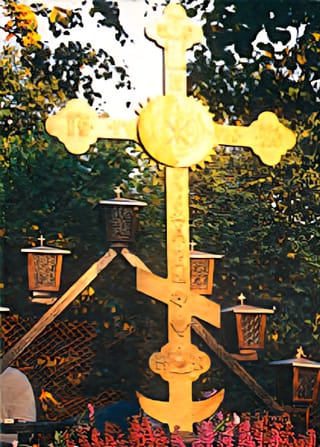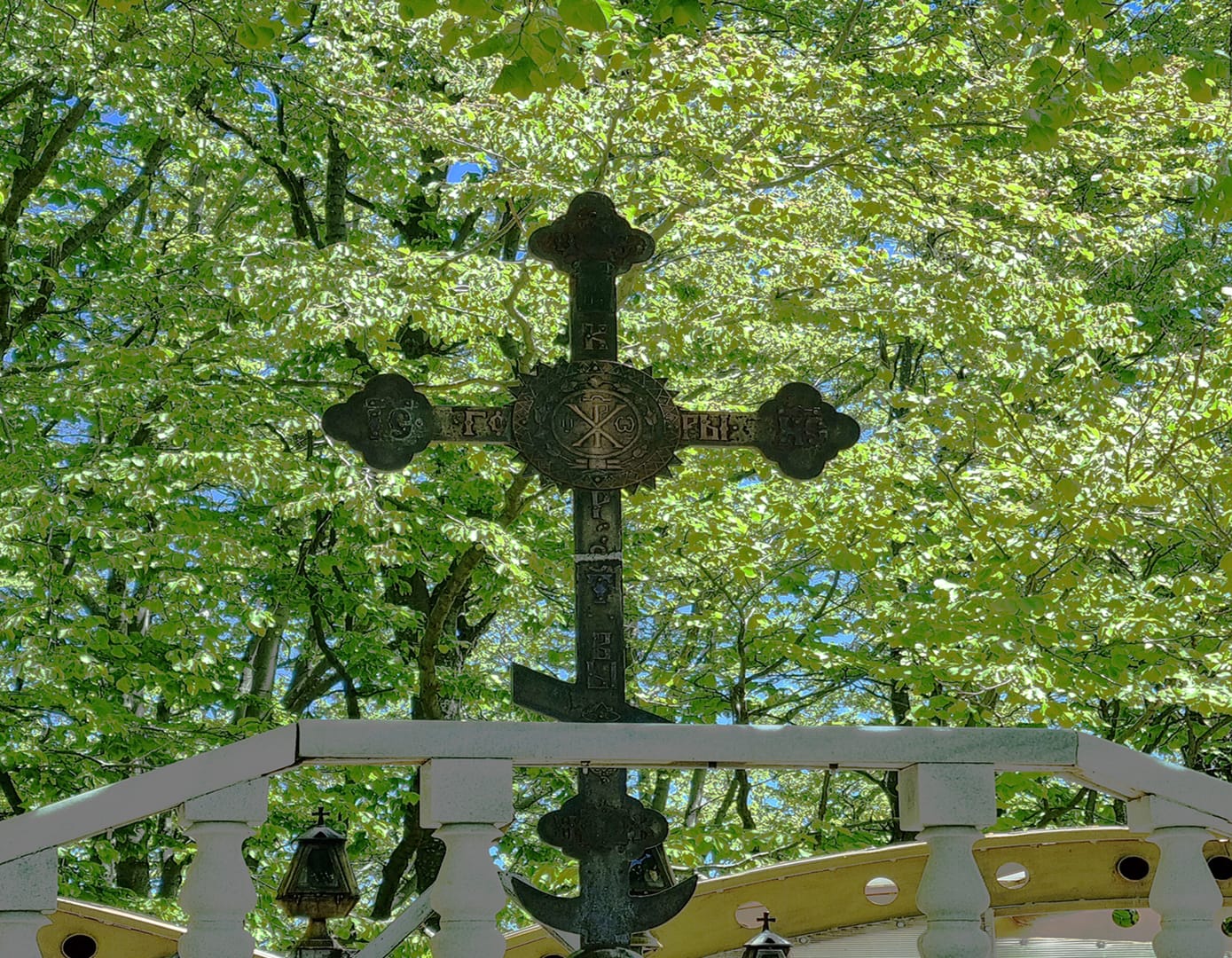История
Великия доместник във Византийската империя Григорий Бакуриани, грузинец по произход,основал през 1083г. Бачковския манастир, дарил го с обширни поземлени имоти,заселил в него 50 души монаси от Грузия и съставил манастирски тапик /устав/. България тогава се намирала под Византийска власт /1018-1185г./. В манастира било открито богословно училище, в което преподавали бележитите грузински учени Йоан Петрици, Икал-тоели, Арсен и др.
А в раздела „За свещените съкровища и честните свети икони“ Бакуриани пише: „Подарих на манастира и две икони от златна сплав, които имат по края големи отломки от светия Христов кръст. Голямата икона се казва „Свето преображение Господне“, а по-малката - „Света Богородица“. Както е известно, св. царица Елена пренесла от Йерусалим в Цариград голямата част от Христовия кръст. Като близък на византийският император Алексий I Комнин, Григорий се сдобил с отломки от тази свещена реликва, вградени в упоменатите две икони.
Манастирският типик не допускал семейни грузинци да живеят под манастирската стряха. За голямото множество негови подчинени преданието допълва, че било образувано селище под името „Иверце“. Селището Иверце, заобиколено от обширна плодородна земя, близки гори и поляни с богати пасища, се превърнало в стопанско средище и в богат животновъден край. Многобройните манастирски стада пасели из живописната местност „Кръстова гора“, наричана още „Градище“, която по форма прилича на кръст. Тук се намирали манастирските мандри и големи жилищни сгради с църква „Света Троица“.

И на Кръстова гора възникнал манастир, наричан Троицки, подчинен на Бачковския. Той станал любимо място на жителите от околните села, особено на иверци. Монасите от Кръстова гора и жителите на с. Иверце измолили от игумена на Бачковския манастир да им подари голямата Бакурианова икона с вградената в нея част от животворящия Христов кръст, за да украсят Троицкия манастир, в който природен кът ръката на Твореца чудно изваяла кръстния знак. Легендата говори, че всяка година на празника Кръстовден - Въздвижение на честния кръст, с тържествено литийно шествие при многобройно присъствие на християни - голямата икона „Св. Преображение Господне“ била носена от Кръстова гора до Бачковския манастир, престоявала там на Всенощното бдение, а на другия ден след Св. Литургия пак тържествено била връщана.
До края на XIIв. монашеските братства на Бачковския и Троицкия манастир били поддържани предимно от нови грузински попълнения. След падането ни под турско робство в 1393г. В Бачковския манастир нахлува гръцката деспотия и станало това, от което най-много се страхувал Бакуриани: гърците изгонили последните грузински монаси, сринали до основи великолепната гробница на братята Григорий и Абасий Бакуриани в централния храм и се постарали да заличат всяка иверска следа.
Особено черни дни и разделно време настъпили за тази част на Родопа в началото на XV в., когато по течението на р. Чая и Лъкинското дефиле внезапно се втурнали многочислените орди на Джадит Али паша. Грабили те, безчестили, клали. В бързината изплашените монаси в Кръстова гора побързали да скрият в земята скъпоценната икона с отломките от кръста Господен и други ценности. Монасите били изклани, църквата и сградите осквернени, ограбени и опожарени, стадата били отвлечени от нашествениците. В близките до Кръстова гора села Дряново, Телица, Мостово, Джурково и др. пашата, който водил със себе си ходжи и имами, оставил някои от тях с поръчение насила да ислямизират населението. Помаците в тези села обаче запазили езика и обичаите си, българските народни песни и легенди, те продължавали да идват на Кръстова гора за празника „Света троица“ и да „принасят курбан“, участвали също в литийното шествие на Кръстовден.
Намиране на животворящият кръст Господен
Малко по-нагоре беше казано, че Григорий Бокурианин вгражда частици от Христовия кръст в подарените от него две икони на Бачковския манастир. Макар и да е известна историята ще приведем отново един фрагмент за чудото с Христовия кръст. Усърдна помощница на император Константин била майка му Елена, чиято християнска дейност се изразявала в широка благотворителност на бедните и в построяване на много храмове. С името на царица Елена е свързано великото събитие в Християнската църква – намиране на животворящия кръст Господен.
Царица Елена в чест на победата на синът ѝ цар Константин над Максенций и провъзгласяването му за император на цялата Римска Империя решила да построи на Голготския хълм Величествен храм - Св. Възкресение Христово. Когато започнали да копаят основите, открили трите кръста – Христовия и на двамата разбойници. И трите кръста много си приличали и кой е на Христа не могли да определят. В това време минавало погребално шествие. Царица Елена спряла шествието и допряла първия и втория кръст до ковчега на покойния младеж. Нищо не се получило. Но когато допряла кръста, на който бил разпнат Иисус Христос, станало чудо: мъртвецът оживял и се изправил. Това чудо зарадвало клетата майчица и сродници, които придружавали погребението и те започнали да прегръщат момчето. Други, които придружавали царица Елена прегръщали и целували Кръста Господен.
Така кръстът от средство за наказание станал средство за спасение. Кръстът станал символ и знаме на Християните и с него те побеждавали всяко зло. Това станало на 14 септември – денят определен за поклонение на Св. Кръст и го наименували Всемирното Въздвижение на Чесния Кръст. Всяка година на 14 септември Св. Кръст се изнасял за поклонение и колкото болни потърсели Божията милост, я получавали. Но знаем, че християнството се е разпространило по цялата земя, но тъй като нямало превозни средства освен магарето, конят, камилата, лодките, хората не можели да дойдат и да се поклонят на Животворния Кръст. Благоразумни християни решили да разделят Св. Кръст на три части: една част останала в Йерусалим, друга изпратили в Рим и трета част в Константинопол (Цариград). Частта която дали на Костантинополската Патриаршия, била сложена в специална ракла, обкована със злато и сребро.

